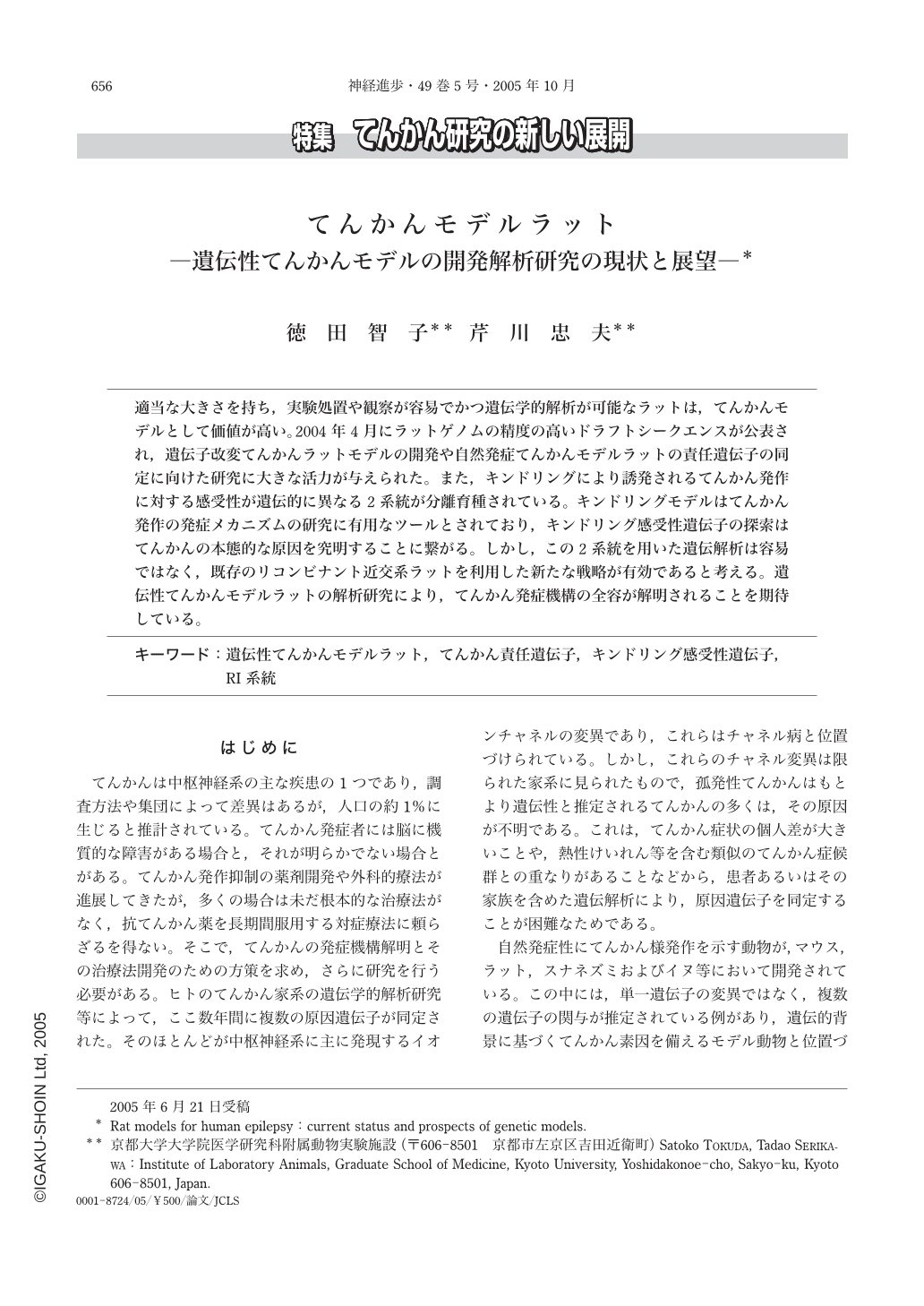Japanese
English
- 有料閲覧
- Abstract 文献概要
- 1ページ目 Look Inside
適当な大きさを持ち,実験処置や観察が容易でかつ遺伝学的解析が可能なラットは,てんかんモデルとして価値が高い。2004年4月にラットゲノムの精度の高いドラフトシークエンスが公表され,遺伝子改変てんかんラットモデルの開発や自然発症てんかんモデルラットの責任遺伝子の同定に向けた研究に大きな活力が与えられた。また,キンドリングにより誘発されるてんかん発作に対する感受性が遺伝的に異なる2系統が分離育種されている。キンドリングモデルはてんかん発作の発症メカニズムの研究に有用なツールとされており,キンドリング感受性遺伝子の探索はてんかんの本態的な原因を究明することに繋がる。しかし,この2系統を用いた遺伝解析は容易ではなく,既存のリコンビナント近交系ラットを利用した新たな戦略が有効であると考える。遺伝性てんかんモデルラットの解析研究により,てんかん発症機構の全容が解明されることを期待している。
Epilepsy is one of the most common neurological disorders. It is characterized by spontaneously recurrent seizures due to excessive discharges of cerebral neurons. Some epilepsy genes have been identified in human, and many of them encode ion channels expressed in the brain. However, the majority of the epilepsy genes have not yet been identified. The pathogenesis of the epilepsy also remains unclear.
Rats can provide excellent models for human epilepsy because they are big enough to be utilized for anatomical micromanipulations or long term observations, e. g. electroencephalography(EEG). The genome sequence of the rat was reported in April 2004 along with several advanced tools for genetic analysis in rats. This has strongly facilitated the development of genetically modified strains and accelerated the identification of causative genes in mutant models.
SER, which is a double mutant rat derived from tremor and zitter rats, shows both absence-like seizures and tonic convulsions which are inhibited by clinical anti-epileptic drugs. These causative genes, tm and zi, were identified by positional cloning approaches. SER as well as TRM, which is the parent strain of SER, have both contributed to the development of new pharmacological and genetic therapies for epilepsy. Candidate loci of NER, GAERS and WAG were mapped by Quantitative Trait Loci(QTL)analysis. Interestingly, QTLs mapped for each strain were different. It suggests that different mechanisms underlie the seizures of each strain. NER is characterized by tonic-clonic convulsions;GAERS and WAG/Rij are used as models of absence seizures. These epileptic rats can play important roles for understanding complicated human epilepsy.
Seizure-prone or resistant rat strains induced by kindling, auditory stimuli or tossing procedures are useful for the study of genetic predisposition of epilepsy. The findings in kindling models are especially essential in the investigations of complex partial seizures.
FAST(kindling-prone)and SLOW(kindling-resistant)rat strains were developed by selective-breeding based on amygdale-kindling rates from a parent population of Long Evans(LE)and Wistar rats. The phenotypic difference between FAST and SLOW rats has been found in the spread of afterdischarge of the seizure focus and the recruitment of other parts in their brains. Further electrophysiological examinations revealed that these two strains differ in their inhibitory mechanisms. Comparison of the phenotypes between FAST and SLOW rats should provide much more information on the epileptogenesis. In addition, the identification of genes associated with the sensitivity for kindling-induced seizures is very important to understand mechanism of the epileptic seizures. Recombinant inbred(RI)strains are a useful genetic tool for gene mapping and analysis of complex and polygenic traits as it occurs in FAST and SLOW rats. The QTL analysis for kindling-induced seizures using established RI strain sets like LEFX and FXLE should make the mapping of the involved genes much more efficient than the genetic analysis using FAST and SLOW. Moreover, not only kindling but also other factors(ex., auditory stimulations and EEG measurements)can be applied to identify more genes associated with epileptic seizures.
We expect that the development and analysis of genetic rat models for epilepsy can lead to clear the etiology of human epilepsy.

Copyright © 2005, Igaku-Shoin Ltd. All rights reserved.


